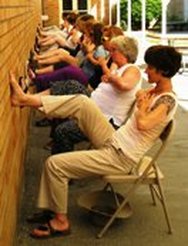Chairs

CHAIRS are a cultural artifact that spare humans the more difficult task of getting up from, and sitting down on, the ground. Unfortunately, this ubiquitous labor-saving device inhibits our full anatomical potential, and — if not properly utilized — sets us up for deterioration. This program intends to shake us from our habitual maladaptive use of chairs. It offers many short processes designed to enrich us with options for dynamic sitting, as well as to promote more proportional coordination. Further, movements made while seated emphasize transmission of force throughout the entire skeleton — essential for the efficient cultivation of bone strength.
By virtue of its form, seated posture is patterned on four-legged posture; this becomes clear when you consider the 90° angle formed between thighs and trunk. Sitting thus provides an inherent corrective in terms of revisiting the tried-and-true survival patterns of our evolutionary forebears...provided, of course, that our sitting is not restrained, nor limits the endless variety of movements of which we are capable — which, in turn, hallmark a healthy, expressive life.
Selective use of a chair’s confinement can also produce desirable results that are not as easily obtained through other means. For example, when seated, facing a wall, with one foot pushing the wall, it is easy to elicit a rounding of the lumbar spine and the entire lower back — which fosters a better aligned bridge for the transmission of force in daily life, modeling a safe pattern for partnering a stepping foot.
For more information from the Foundation for Movement Intelligence , click here
